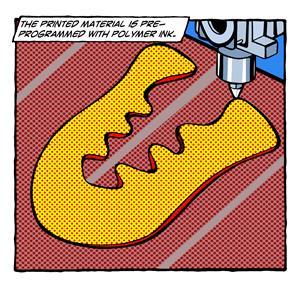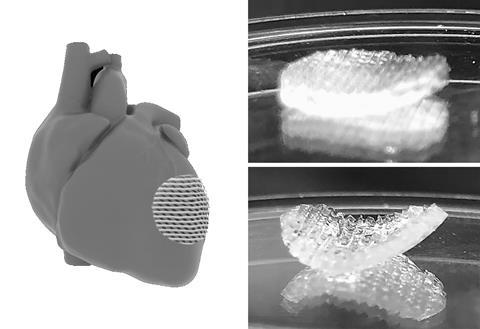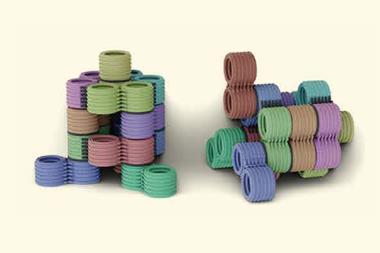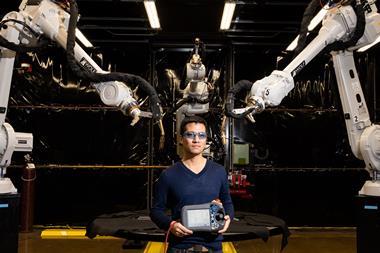Nina Notman learns how 4D printing is opening the door to unique smart materials whose applications may only be limited by our imaginations
Smart materials are already part of our daily lives. From novelty mugs with thermochromic pigments that change colour when holding a hot drink, to photochromic prescription glasses’ lenses that darken when the sun is out, to hydrogels that expand to soak up liquid in disposable nappies and period products. But these are only the tip of the iceberg in terms of what smart materials – that can sense information about the environment around them and then act accordingly – are predicted to achieve in the future.
According to a recent Royal Society report, smart materials on the way include window glass that changes porosity in response to humidity, clothing that adapts to environmental conditions and self-healing concretes. ‘Animate materials could eventually have a transformative effect on all spheres of life,’ the report authors wrote.
We are 3D printing things that then change over time
The key point is that these are not autonomous systems comprised of sophisticated electronics and robotics. The ability to sense stimuli and respond appropriately is instead preprogrammed into the design of a single material.



Printing the future
Smart materials will need to jump many hurdles before they can reach their full potential, including how best to manufacture them. Over the past decade or so, increasing numbers of researchers have been exploring the potential of 3D printers for this purpose.
The use of 3D printers to produce smart materials is called 4D printing, a term coined by Skylar Tibbits, an architect and computer scientist at the Massachusetts Institute of Technology in the US, during a TED talk in 2013. ‘The fourth dimension [is] time,’ he tells Chemistry World. ‘We are 3D printing things that then change over time – that reconfigure, that evolve, that adapt, that have agency.’
Using 3D printers for smart materials has many of the same advantages as it does for static objects, including the ability to make personalised, made-to-measure materials. Allowing access to types of materials that are impractical to produce any other ways is another. ‘It is almost impossible to fabricate [our smart materials] using the commercial fabrication approach – or at least it would be extremely tedious,’ explains Jerry Qi, a mechanical engineer from the Georgia Institute of Technology in the US.
This ease of manufacture also accelerates innovation. ‘Previously, once you’ve designed a [smart] material, then you have to figure out how to fabricate it, which is going to take you probably half a year to achieve,’ Qi says. It is now possible for researchers to get their hands on a new prototype within hours rather than months of designing it.
Printing lifestyle products
It is still early days for 4D printing and no smart materials made this way are yet in commercial use, although plenty of prototypes have been developed. One of Tibbits’ early designs was a 4D printed shoe. His group printed a preprogrammed pattern of polymer ink onto a stretched piece of textile fabric. After the fabric was released from its stretch, the 2D shape immediately jumped up into the intended 3D shape. ‘It’s a jack-in-the-box effect,’ explains Tibbits. He also used the same trick to produce a 4D printed dining table prototype designed to be flat-packed and then to instantly spring up into the 3D shape once unpacked. For this table, an ink composed of polymer and sawdust was printed onto the fabric.
We can print high-quality products at large scale, super fast
The Tibbits group has also created a 4D printed stretchy, inflatable silicone prototype material with tuneable stiffness in conjunction with the car manufacturer BMW. The smart material changes shape in response to the amount of air pumped into it. ‘With BMW, we were looking at the future of the car interior [and investigating] how materials could morph and transform in the car based on pressure differential,’ Tibbits says. A potential use is in car seats, enabling them to become softer or harder, or to provide greater lumbar support, without the need for complicated mechanical mechanisms, he adds.
To make its pneumatic material, Tibbits’ group developed a novel type of 3D printing technology – rapid liquid printing. Unlike most 3D printing approaches, rapid liquid printing doesn’t build up objects layer by layer. Instead, the liquid 3D object is printedinto a tank containing a gel, which suspends the object so it is not subject to gravity. The ink contains polymers that rapidly solidify once combined or when exposed to ultraviolet light. Rapid liquid printing overcomes some of the inherent shortcomings of 3D printing, namely size limitations and slow speed, says Tibbits. ‘We can print high quality products at large scale, super fast.’ The group is now exploring the use of this printing approach for a wide variety of smart materials.
Next generation stents
Unlike Tibbits, who is focused on 4D printing approaches to manufacturing lifestyle products, many other researchers who are championing this technology are concentrating on potential biomedical applications.
The use of 3D printers to produce personalised static objects is already becoming established in healthcare. Examples include personalised digital hearing aids that fit in the ear or soft earmoulds for behind-the-ear aids; 3D models of organs and other body parts on which to practice complicated surgeries; components of prosthetics that perfectly match a person’s anatomy; and low-cost, made-to-measure implants such as jaws, hips and pieces of skull.
Devices that can change shape once inside the body are also already in use, but they are made using traditional manufacturing methods. Deployable stents, for example, have been used for treating heart attacks and angina since the 1990s. These cylinders of expandable metal mesh are guided through a patient’s blood vessels while collapsed around a balloon on the end of a narrow wire. Once in the correct location, the balloon is inflated so that the mesh expands to fit the blood vessel wall.

Bioengineer Amir Zadpoor and his group at Delft University of Technology in the Netherlands are looking to 4D printing to make next generation deployable stents. The goal is to produce a smart polymer stent that self-expands at body temperature, therefore removing the need for a balloon-inflation system. Zadpoor’s stents can be a standardised size or personalised for complex scenarios, including at junctions where two blood vessels diverge.
To make the 4D cylinders, the group built an add-on to attach to a commercially available fuse deposition modelling (FDM) printer. The add-on resembles a rolling pin and rotates during printing. When an object is printed on a rotating curved surface instead of a static flat one, its layers are oriented differently, affecting its shape-shifting behaviour. The cylinder now expands in diameter rather than in length, Zadpoor explains.
Origami-like tissue scaffolds
The Zadpoor group is also looking to use 4D printing to produce next-generation tissue engineering scaffolds. These structural scaffolds are implanted into patients to promote the regeneration of bone, muscle, neural and other tissue in situ. 3D printing has already proven itself to be a highly effective tool for producing personalised, highly porous metal lattices for this purpose.
Once you trigger the material, it goes into the required 3D shape
4D printing offers the additional benefit of allowing the surfaces inside the metal lattice pores to be functionalised, Zadpoor says, which can’t be done using traditional manufacturing methods. ‘We can decorate these surfaces with very small geometrical features that we call nanopatterns,’ he explains. The nanopatterns direct cells to become bone-forming cells and also act to reduce bacterial growth. ‘These little spikes can behave like a knife and penetrate into bacteria and kill them in a mechanical way, and they can also modulate the behaviour of immune cells to kill bacteria,’ Zadpoor adds.
An FDM printer is used to print a 2D layered structure that spontaneously folds into a 3D object when stretched. ‘Smartness is incorporated into this material [design] so that once you trigger it using a stimulus, it goes into the required 3D shape,’ says Zadpoor. Unlike the stents, these scaffolds are designed to change shape during the manufacturing process, rather than inside the body.
Mending a broken heart
At the George Washington University in Washington DC, US, bioengineer Grace Zhang and her group are also using 4D printing to make tools capable of supporting tissue regeneration in the body. 4D printed cardiac patches, that repair heart muscle damage caused by heart attacks, are among their efforts. The rhythm of heartbeat is controlled by heart muscle cells, or cardiomyocytes, and it has long been suggested that damaged hearts could be repaired with lab-grown cardiomyocytes, but integrating them efficiently has proven to be a major challenge. ‘When a heart is beating it is really hard to keep the cells in the [desired] location long term,’ explains Zhang.

Her group’s 4D cardiac patches are preprogrammed to hold cardiomyocytes securely on the heart’s surface. They are comprised of a gelatine-based ink andprinted using a custom-designed stereolithography3Dprinter. Gelatine is a hydrolysed form of collagen, a highly abundant protein in the body that serves as a scaffold for cells.By adjusting the degree of cross-linking in the different sections of its design, the patches are designed to reversibly change structure upon stretching so that they can expand and contract along with the heart. ‘We design the patches so that they can perfectly attach without any glue over,’ Zhang explains.
The first-generation cardiac patch has already been tested in mice with induced heart damage. The Zhang group placed the 4D printed patches loaded with lab-grown cardiomyocytes in the mice and observed that they were still in place and supporting heart-muscle formation four months later.
A second-generation 4D printed cardiac patch is also now in development, whereby the ability to self-curl,when triggered by near infrared light, has also been preprogrammed into the cross linkage pattern. This curling mechanism will further improve the patch’s ability to grip onto the heart’s surface, Zhang explains.
4D printed surgeons
Mechanical engineer Xuanhe Zhao and his group at the Massachusetts Institute of Technology in the US, meanwhile, are looking to apply 4D printing to stroke treatment. The researchers are aiming to improve the thrombectomy, a common stroke treatment whereby a thin wire – carrying drugs to break up clots or a device that pulls or sucks out clots – is inserted into a blood vessel in the leg and then manually guided, with the help of real-time x-ray imaging, through the body until it reaches the blockage.
4D printed wires could make this guiding process easier, says Zhao. His group’s wires are designed his wire to change shape, and therefore direction, in response to a magnetic field. Magnets on the outside of the body could be used to direct the wire to travel through the blood vessels. The procedure could even be controlled remotely using a joystick, reducing the surgeon’s radiation exposure, says Zhao. ‘We are moving forward towards clinical application and FDA approval of this stroke robot,’ he adds.
To make the wires, Zhao has designed an electromagnetic add-on that sits next to the nozzle of a commercially available FDM 3D printer. The ink is a soft polymer containing uniformly dispersed ferromagnetic microparticles, which permanently retain magnetism after exposure to a magnetic field. During printing, the electromagnet magnetises and aligns the ferromagnetic microparticles in the ink.
The Zhao group has previously used the same add-on to create a variety of 2D patterns that fold into complex 3D shapes under the control of handheld magnets. ‘With 4D printing you programme these magnetic software robots into very complex structures to achieve many functions,’ Zhao explains.
Fundamental advances
Not everyone working on 4D printing currently has applications in mind; many are working to achieve fundamental advances that others can then take forward for applications. Among Qi and his Georgia Tech group’s endeavours are 4D printed materials with multiple layers of composite shape memory polymers. The researchers use two polymers with mismatched polarity and tightly control their spatial distributions within each layer. This means that when the material is soaked in water or acetone, one polymer swells more than the other and the material bends in a very precise manner.
The fabrication process can be done in less than a minute
The printer they use for this work is a custom-made digital light processing (DLP)-style 3D printer. In DLP printers, the resin is cured using rapid light-triggered polymerisation, which makes them much faster than FDM printers, Qi explains. He also recently developed a machine learning model that eliminates the need for trial and error in the material’s pattern design. Qi can rapidly and accurately produce a composite material pattern based on just a hand-drawn picture of the desired end product shape.
Polymer chemist Tao Xie and his group at Zhejiang University in Hangzhou, China, are also using a custom-made DLP 3D printer to make smart materials containing multiple polymers. It is a modular process with a different polymer in each module. The 3D modules are printed as patterned 2D films. ‘The fabrication process can be done in less than a minute,’ says Xie. The pattern is preprogrammed to do serve two different purposes. First, it directs the transformation of the 2D film into a 3D object as it dries. Second, it allows the 3D object to change shape when exposed to an environmental trigger.
To create more complex shape-shifting materials, the 3D modules are stacked on top of each other and heated to permanently fuse together. ‘It’s like Lego,’ Xie says, adding that this modular approach to 4D printing drastically expands the structural complexity possible for shape-shifting materials. Smart modular materials the group has created so far include a three-layered cylinder that deforms in a controlled manner when heated.
4D printing technology has rapidly evolved since its conception to allow rapid prototyping of a wide variety of shape-shifting materials, but there are still hurdles to overcome before its use becomes mainstream and it is able to produce smart materials on a commercial scale.
Standardisation, according to Tibbits, is one such issue. ‘If we look at the field of 4D printing, everyone’s doing it differently; they all have different materials, machines and software, and they are all testing their systems in different ways,’ he says. To ensure safety and reliability, the community needs to come up with a set of shared standards for testing and analysing these smart materials, he explains.
The biggest challenge of all for 4D printed materials, however, may be one of mindset: how to integrate activity into a world that is used to its materials being static. ‘Normally, engineering is about trying to make structures and bridges that do not change shape – most materials out there trying to be super stable and not move,’ says Tibbits. ‘This is going the complete opposite direction and aiming to use materials that are as active as possible, and we’re not really used to that.’
Nina Notman is a science writer based in Salisbury, UK













No comments yet